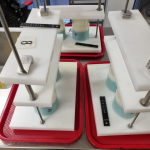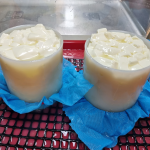In Australia, as does the rest of the world, we have a significant fluctuation in temperatures between summer and winter. Depending on where you live, one region in Australia can have a much colder overnight temperature than another region. In some Southern Australian locations, the overnight temperatures can get to below 0°C, whereas in more northern regions of Australia temperatures may only get to a low of 15°C overnight. That is a big variation in temperatures. As we approach the colder months of the year, and it’s not winter yet, it is worth noting the temperature of your kitchen (or wherever you make your cheese) and the temperature of the hooped curd in the first 24 hours after you have added it to the hoop.
A cheese that is hooped and left in the kitchen on a cold evening will turn out differently from the same cheese that is hooped and left in a kitchen on a warm evening. When the cheese curds are placed into a hoop, the curds are still warm, they have been in the ‘curds and whey’ and they still have a high amount of lactose and water still in them. When you hoop the curds, the starter cultures are still very highly active converting the lactose to lactic acid and this, in turn, shrinks the curd particles and forces water/whey from the curd. On a warm night, it is usually suitable just to leave the cheese curds and the hoop on the bench, and this fermentation process continues at the correct pace, right through to the next day.
You would have seen the volume of curds in a hoop of non-pressed curds at hooping is significantly less the following morning and there is all this whey in the draining tray. However, on a cold night, and while you are warm in bed, the starter culture is working through the night, but the rate at which the starter culture converts the lactose to lactic acid will slow if the temperature cools. This is because the starter cultures are not as active on cold nights, and if it is a very cold night, the starter culture may become completely dormant.
The starter cultures that are not active or are dormant cannot convert the required amount of lactose to lactic acid as well as required. This may result in a cheese that is low in acid and high in moisture. That may not be very good for the final quality of the cheese. The recipe should be based on keeping the curds warm on that first night after hooping. That is important for pressed, non-pressed and lactic set curds.
To keep the culture activity and hence the acid development on track for the first 24 hours after hooping, you should aim to maintain the temperature of the hooped curd at eg >25°C. Especially important is the first few hours after hooping but if possible through the whole night is even better.
There are a few ways that you may be able to do this:
- Place the cheese next to the kettle and place a warm towel over the cheese and the kettle. Turn the kettle on a few times that evening.
- Place the cheese, along with a hot water bottle (or similar), in a well-insulated box, such as a foam box or an esky or in an oven that has been warmed just slightly.
- Next to the hot water system.
- Use a fish tank heater or sous vide heater in a water bath and place the cheese beside it, and cover both with a towel.
Happy cheesemaking
Graham







